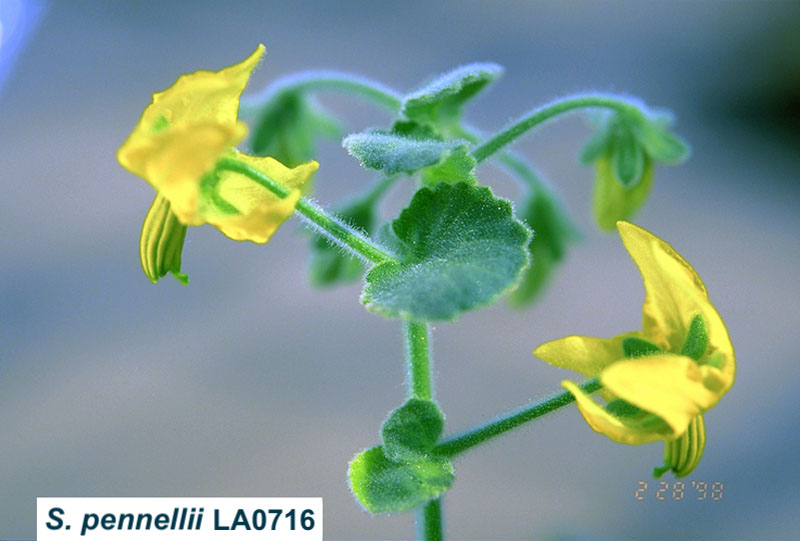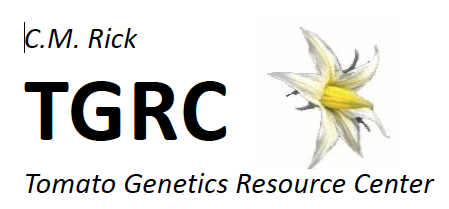
This group of acylsugar breeding lines was bred from S. pennellii LA0716 by Martha Mutschler at Cornell University who provided the following description of the lines:
CU17NBL (LA5346) is an acylsugar benchmark breeding line, which was developed to replace the former benchmark line, CU071026. CU071026 had reproductive limitations, setting fruit in the Ithaca NY area only when sown in November or December in the greenhouse. When sown from May to about October, and grown in greenhouse or field (in summer) CU071026 flowers but either does not set any fruit, or sets very few fruit with little seed. Seed of CU071026 also have lower germination percentages than standard tomato. CU17NBL produces essentially the same type of acylsugar, at the same level, as CU071026, however CU17NBL sets fruit and seed normally year round and its seed has normal germination. The creation of the major Cornell acylsugar lines including CU071026 and CU17NBL is reviewed in Mutschler (2021).
CU17NBL has 5 S. pennellii introgressions which combined are ca. 11% of the CU17NBL genome. The locations and sizes of these locations using the 2.5 genome build are:
• Chromosome 2: the Chr2 intogression, from 53,792,960 - 55,238,304 bp: Therefore, 1,445,344 bp in length
• Chromosome 3: the Chr3 intogression, from 2,143,744 - 64,451,474 bp: Therefore 62,307,730 bp length
• Chromosome 7: the Chr7 intogression, from 65,554,074 – 65,801,666 bp: Therefore 1,445,344 bp in length
• Chromosome 8: the Chr8 intogression, from 60,843,834 – 63,384,503 bp: Therefore 1,445,344 bp in length
• Chromosome 10: the Chr10U intogression, from 0 - 1,916,909 bp: Therefore 1,445,344 bp in length
CU17NBL is the background into which a series of lines has been created and deposited into the USDA germplasm collection. This series of lines was created by transferring 1 to 3 additional S. pennellii introgressions into CU17NBL from a line of the set of lines previously created in the CU071026 set of acylsugar lines.
The genome of CU17NBL has been sequenced, and the raw data (from two reps) are available here:
https://www.ncbi.nlm.nih.gov/sra/SRX13451742[accn]
https://www.ncbi.nlm.nih.gov/sra/SRX13451728[accn]
QTL6/CU17NBL (LA5347) is a line derived in the CU17NBL acylsugar benchmark breeding line by transferring the QTL6 introgressions, which increases acylsugar level and increases the density of Type IV trichomes which produce and exude acylsugars. The source of the QTL6 and the Sw-5 containing introgressions to create QTL6/CU17NBL and QTL6/Sw-5/CU17NBL lines was the analogous line in CU071026, QTL6/Sw-5/ CU071026. The QTL6/CU17NBL and QTL6/Sw-5/CU17NBL lines are very similar in acylsugar level and acylsugar types to that of their analogous lines in CU071026 background: QTL6/ CU071026 and QTL6/Sw-5/ CU071026 lines. The impacts of increased acylsugar level of QTL6/ CU071026 and QTL6/Sw-5/ CU071026 lines on Bemisia whitefly oviposition is in Leckie et al (2012).
QTL6/Sw-5/CU17NBL (LA5348) is a line derived in the CU17NBL acylsugar benchmark breeding line by transferring the QTL6 introgressions, which increases acylsugar level and increases the density of Type IV trichomes which produce and exude acylsugars. The only difference between Sw-5/CU17NBL and QTL6/CU17NBL is the absence and presence of the Sw-5 containing introgression. The immediate source of the QTL6 and the Sw-5 containing introgressions to create QTL6/CU17NBL and QTL6/Sw-5/CU17NBL lines was the analogous line in CU071026, QTL6/Sw-5/ CU071026.
ModQTL6/Sw-5/CU17NBL (LA5349) is a related line in which the distal end of the QTL6 introgression has been shortened, which appears to increase seed production. The ModQTL6/Sw-5/CU17NBL and QTL6/Sw-5/CU17NBL lines are very similar in acylsugar level and acylsugar types to each other and to that of their analogous lines in CU071026 background: QTL6/Sw-5/ CU071026 lines.
Sw-5/CU17NBL (LA5350) is a line derived in the CU17NBL acylsugar benchmark breeding line by transferring an introgression containing the Sw-5 gene for resistance to TSWV. The Sw-5/CU17NBL line was created as an additional line from the segregating population used to create the lines QTL6/CU17NBL and QTL6/Sw-5/CU17NBL. The immediate source of the Sw-5 containing introgression to create the Sw-5/CU17NBL lines was the line in CU071026, QTL6/Sw-5/CU071026.
CU17NBL/NO 8 (LA5351) is a variant of CU17NBL that lacks one introgression, that is on chromosome 8. The acylsugars produced by CU17NBL/NO 8 are similar to those in CU17NBL, although the level of acylsugars in CU17NBL/NO 8 is less than that in CU17NBL.
FA2/CU17NBL (LA5352) is a line derived in the CU17NBL acylsugar benchmark breeding line by transferring the FA2 introgression into CU17NBL. The FA2 QTL modifies the fatty acid chains of the acylsugars produced, increasing the length of branched chain fatty acids from the original 4 or 5 carbons, by 6 to 8 additional carbons. The FA2QTL containing introgression was transferred into the prior benchmark line, CU071026, as described in Smeda (2016), and the epistatic interaction of FA2 with the FA7 QTL, which also affects acylsugar fatty acid side chains, was described in Smeda et al (2017).
FA7/CU17NBL (LA5353) is a line derived in the CU17NBL acylsugar benchmark breeding line by transferring the FA7 introgression into CU17NBL. The FA7QTL containing introgression was transferred into the prior benchmark line, CU071026, as described in Smeda et al (2016), and the epistatic interaction of FA7 with the FA2 QTL, which also affects acylsugar fatty acid side chains, was described in Smeda et al (2017).
FA2/FA7/CU17NBL (LA5354) is a line derived in the CU17NBL acylsugar benchmark breeding line by transferring both the FA2 and FA7 containing introgressions into CU17NBL background. As shown by Leckie et al (2014), the FA2 QTL modifies the fatty acid chains of the acylsugars produced, increasing the length of branched chain fatty acids from the original 4 or 5 carbons, by 6 to 8 additional carbons. The FA7 QTL modifies the fatty acid chains of the acylsugars produced, decreasing the length of moderate length fatty acids from by 2 carbons.
FA5/CU17NBL (LA5355) is a line derived in the CU17NBL acylsugar benchmark breeding line by transferring the FA5 containing introgression. As shown by Smeda et al. (2016), the FA5 introgression essentially shuts down acylsugar production, despite having the five acylsugar QTL introgressions in CU17NBL. This line thus serves as a negative control for acylsugar production.
CU071026 (LA5356) is the acylsugar benchmark breeding line from which CU17NBL was selected. It has the same introgressions as CU17NBL. Each of the lines in the CU17NBL background are very similar in acylsugar level and acylsugar types to that of their analogous lines in the CU071026 background.
ACYLGLU/CU17NBL (LA5414) is a high acylglucose breeding line in CU17NBL background with four additional introgressions on chromosomes 3 (63.28-65.14Mbp), 4 (4.001-32.86Mbp), 11 (51.04-53.54Mbp), and 12 ( 0-3.051Mbp).
To request seed, please contact Emily Ann Courson (eac293@cornell.edu) to obtain and approve the Material Transfer Agreement with Cornell University that applies to these lines. After you have approved their MTA, you may submit a seed request to the TGRC.
References:
Leckie, BM, DeJong, DM, and M.A. Mutschler (2012) Quantitative trait loci increasing acylsugars in tomato breeding lines and their impacts on silverleaf whiteflies. Molecular Breeding 30 (4): 1621-1634.
Leckie, BM, R Halitschke, DM De Jong, JR Smeda, A Kessler, and MA Mutschler (2014) Quantitative trait loci regulating the fatty acid profile of acylsugars in tomato. Molecular Breeding 34 (3): 1201-1213.
Mutschler, MA (2021) Breeding for Acylsugar Mediated Control of Insects and Insect Transmitted Virus in Tomato. IN: Plant Breeding Review vol 45. Goldman I ed.
S Pandey, ALBR da Silva, B Dutta, JH Chong, MA Mutschler, JM Schmidt 2023 Acylsugar tomato lines suppress whiteflies and Amblyseius swirskii establishment Entomologia Experimentalis et Applicata
Smeda JR, AL Schilmiller, TA Anderson, S Ben-Mahmoud, DE Ullman, TM Chappell A Kessler, MA Mutschler (2018) Combination of Acylglucose QTL Reveals Additive and Epistatic Genetic Interactions and Impacts Insect Oviposition and Virus Infection. Molecular Breeding 38: 3.
Smeda JR., AL Schilmiller, A Kessler, MA Mutschler (2017) Combination of QTL Affecting Acylsugar Chemistry Reveals Additive and Epistatic Genetic Interactions to Increase Acylsugar Profile Diversity. Molecular Breeding 37 (104).
Smeda JR, AL Schilmiller, RL Last, MA Mutschler (2016) Introgression of acylsugar chemistry QTL modifies the composition and structure of acylsugars produced by high-accumulating tomato lines. Molecular Breeding 36 (160).
Smeda, JR, HA. Smith, MA Mutschler 2023 The amount and chemistry of acylsugars affects sweetpotato whitefly (Bemisia tabaci) oviposition and development, and tomato yellow leaf curl virus incidence, in field grown tomato plants.
DE Ullman, MA Mutschler, GG Kennedy 2023 Acylsugar-mediated resistance as part of a multilayered defense against thrips, orthotospoviruses, and beyond. Current Opinion in Insect Science.
(last updated 2/4/2025)
